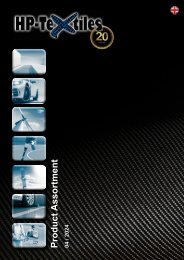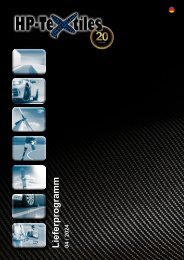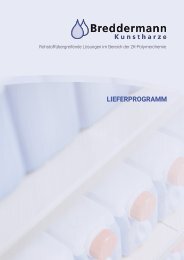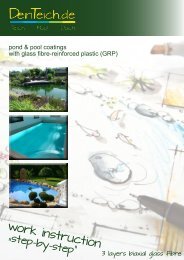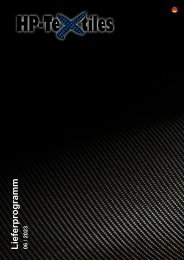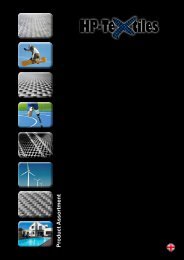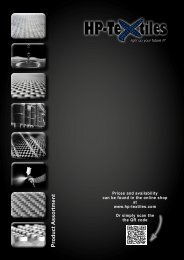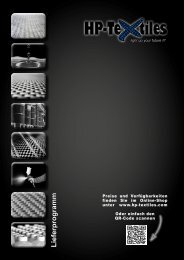Catalog_02/2021_Englisch
In this catalog you will find the entire range of HP-Textiles GmbH.
In this catalog you will find the entire range of HP-Textiles GmbH.
You also want an ePaper? Increase the reach of your titles
YUMPU automatically turns print PDFs into web optimized ePapers that Google loves.
OVERVIEW GLASS FILAMENT FABRIC<br />
Glass-Filament-Fabrics are weaved panels consisting of endless E-Glass-Yarn. The glass yarn is a spinning<br />
thread which is provided with a slight turning (approx. 20 - 40 turnings per meter). Glass fibre threads consist of<br />
several glass yarns which are twisted together.<br />
The properties of textile glass materials as reinforcing materials are determined by the fineness and sizing of the<br />
spinning thread. The sizing of the thread is a thin coating based on chrome or silane compounds. It is applied with<br />
an application roll while the pulling process.<br />
The mechanical basic features (e.g. tensile strength, tensile moduls of elasticity, elongation at break) are determined<br />
by the glass type, the application and the sizing of the thread. These include smoothness and sliding ability<br />
while processing with the textiles, the compatibility of the glass surfaces and the resin matrix and hereby the<br />
implementation of the mechanical basic features onto the composite material.<br />
E-Glass Description<br />
Glasstype<br />
Density<br />
kg/dm³<br />
Softening<br />
temperature °C<br />
Tensilstrength<br />
MPA<br />
Elasticity<br />
modul GPa<br />
Elongation<br />
%<br />
Thermal conductivity<br />
W(m.K)<br />
E-Glas 2,59 - 2,62 825 - 860 2600 73 3,5 - 4 0,15<br />
Comparison: Silane / Finish<br />
SILANE<br />
FINISH<br />
PREPARATION The sizing is applied during the<br />
production of the yarn on the basis<br />
of a universal Silane bonding agent.<br />
Silane fabrics need no further treatment and<br />
are directly applicable in the fibre composite.<br />
The fabric is first prepared from a textile fibre- glass.<br />
Thereafter, the textile glass sizing is burned.<br />
And then a special bonding agent,<br />
the so-called finish is applied.<br />
The finish consists of a bifunctional chemical<br />
compound. This compound optimized<br />
on the one hand the binding to the<br />
resin and on the other hand to the fibre.<br />
Glass<br />
PROPERTIES • Good mechanical properties in the<br />
laminate<br />
• Transparent laminates<br />
• Low Fibre Print<br />
• Very cheap<br />
• Suitable for EP and UP resin<br />
APPLICATIONS • boat building<br />
• Good impregnation of the fibre<br />
• sport equipments<br />
• vehicle industrie<br />
• model and mould components<br />
• Very good mechanical properties in the<br />
laminate<br />
• Very transparent laminates<br />
• Low Fibre Print<br />
• Very high-quality<br />
• Very suitable for EP and UP resin<br />
• Outstanding impregnation of the fibre<br />
• Very low dust during cutting<br />
• For the first layer(s) after the mold cover<br />
layer, since they not stand out from<br />
the surface.<br />
• boat building<br />
• sport equipments<br />
• vehicle industrie<br />
• model and mould components<br />
• wood and venner coatings<br />
phone: +49 (0) 5905-9459870 www.hp-textiles.com mail: info@hp-textiles.com 39



